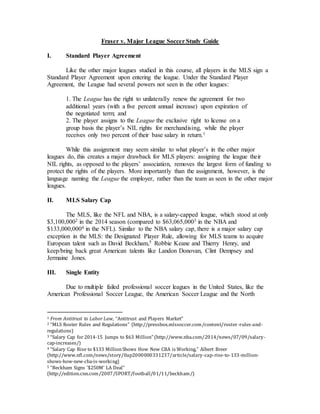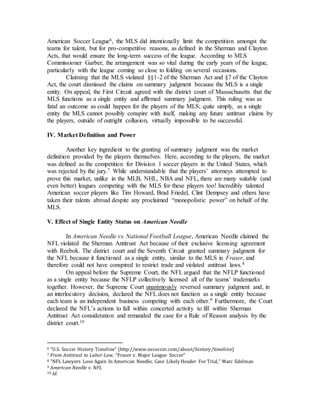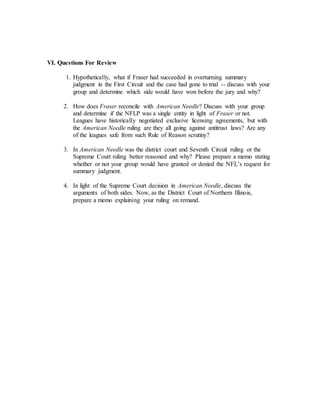Fraser v MLS Study Guide
- 1. Fraser v. Major League Soccer Study Guide I. Standard Player Agreement Like the other major leagues studied in this course, all players in the MLS sign a Standard Player Agreement upon entering the league. Under the Standard Player Agreement, the League had several powers not seen in the other leagues: 1. The League has the right to unilaterally renew the agreement for two additional years (with a five percent annual increase) upon expiration of the negotiated term; and 2. The player assigns to the League the exclusive right to license on a group basis the playerâs NIL rights for merchandising, while the player receives only two percent of their base salary in return.1 While this assignment may seem similar to what playerâs in the other major leagues do, this creates a major drawback for MLS players: assigning the league their NIL rights, as opposed to the playersâ association, removes the largest form of funding to protect the rights of the players. More importantly than the assignment, however, is the language naming the League the employer, rather than the team as seen in the other major leagues. II. MLS Salary Cap The MLS, like the NFL and NBA, is a salary-capped league, which stood at only $3,100,0002 in the 2014 season (compared to $63,065,0003 in the NBA and $133,000,0004 in the NFL). Similar to the NBA salary cap, there is a major salary cap exception in the MLS: the Designated Player Rule, allowing for MLS teams to acquire European talent such as David Beckham,5 Robbie Keane and Thierry Henry, and keep/bring back great American talents like Landon Donovan, Clint Dempsey and Jermaine Jones. III. Single Entity Due to multiple failed professional soccer leagues in the United States, like the American Professional Soccer League, the American Soccer League and the North 1 From Antitrust to Labor Law, âAntitrust and Players Marketâ 2 âMLS Roster Rules and Regulationsâ (http://pressbox.mlssoccer.com/content/roster-rules-and- regulations) 3 âSalary Cap for 2014-15 Jumps to $63 Millionâ (http://www.nba.com/2014/news/07/09/salary- cap-increases/) 4 âSalary Cap Rise to $133 MillionShows How New CBA is Working,â Albert Breer (http://www.nfl.com/news/story/0ap2000000331237/article/salary-cap-rise-to-133-million- shows-how-new-cba-is-working) 5 âBeckham Signs â$250Mâ LA Dealâ (http://edition.cnn.com/2007/SPORT/football/01/11/beckham/)
- 2. American Soccer League6, the MLS did intentionally limit the competition amongst the teams for talent, but for pro-competitive reasons, as defined in the Sherman and Clayton Acts, that would ensure the long-term success of the league. According to MLS Commissioner Garber, the arrangement was so vital during the early years of the league, particularly with the league coming so close to folding on several occasions. Claiming that the MLS violated §§1-2 of the Sherman Act and §7 of the Clayton Act, the court dismissed the claims on summary judgment because the MLS is a single entity. On appeal, the First Circuit agreed with the district court of Massachusetts that the MLS functions as a single entity and affirmed summary judgment. This ruling was as fatal an outcome as could happen for the players of the MLS; quite simply, as a single entity the MLS cannot possibly conspire with itself, making any future antitrust claims by the players, outside of outright collusion, virtually impossible to be successful. IV. Market Definition and Power Another key ingredient to the granting of summary judgment was the market definition provided by the players themselves. Here, according to the players, the market was defined as the competition for Division 1 soccer players in the United States, which was rejected by the jury.7 While understandable that the playersâ attorneys attempted to prove this market, unlike in the MLB, NHL, NBA and NFL, there are many suitable (and even better) leagues competing with the MLS for these players too! Incredibly talented American soccer players like Tim Howard, Brad Friedel, Clint Dempsey and others have taken their talents abroad despite any proclaimed âmonopolistic powerâ on behalf of the MLS. V. Effect of Single Entity Status on American Needle In American Needle vs. National Football League, American Needle claimed the NFL violated the Sherman Antitrust Act because of their exclusive licensing agreement with Reebok. The district court and the Seventh Circuit granted summary judgment for the NFL because it functioned as a single entity, similar to the MLS in Fraser, and therefore could not have conspired to restrict trade and violated antitrust laws.8 On appeal before the Supreme Court, the NFL argued that the NFLP functioned as a single entity because the NFLP collectively licensed all of the teamsâ trademarks together. However, the Supreme Court unanimously reversed summary judgment and, in an interlocutory decision, declared the NFL does not function as a single entity because each team is an independent business competing with each other.9 Furthermore, the Court declared the NFLâs actions to fall within concerted activity to fill within Sherman Antitrust Act consideration and remanded the case for a Rule of Reason analysis by the district court.10 6 âU.S. Soccer History Timelineâ (http://www.ussoccer.com/about/history/timeline) 7 From Antitrust to Labor Law, âFraser v. Major League Soccerâ 8 âNFL Lawyers Lose Again In American Needle; Case Likely Header For Trial,â Marc Edelman 9 American Needle v. NFL 10 Id.
- 3. VI. Questions For Review 1. Hypothetically, what if Fraser had succeeded in overturning summary judgment in the First Circuit and the case had gone to trial -- discuss with your group and determine which side would have won before the jury and why? 2. How does Fraser reconcile with American Needle? Discuss with your group and determine if the NFLP was a single entity in light of Fraser or not. Leagues have historically negotiated exclusive licensing agreements, but with the American Needle ruling are they all going against antitrust laws? Are any of the leagues safe from such Rule of Reason scrutiny? 3. In American Needle was the district court and Seventh Circuit ruling or the Supreme Court ruling better reasoned and why? Please prepare a memo stating whether or not your group would have granted or denied the NFLâs request for summary judgment. 4. In light of the Supreme Court decision in American Needle, discuss the arguments of both sides. Now, as the District Court of Northern Illinois, prepare a memo explaining your ruling on remand.


